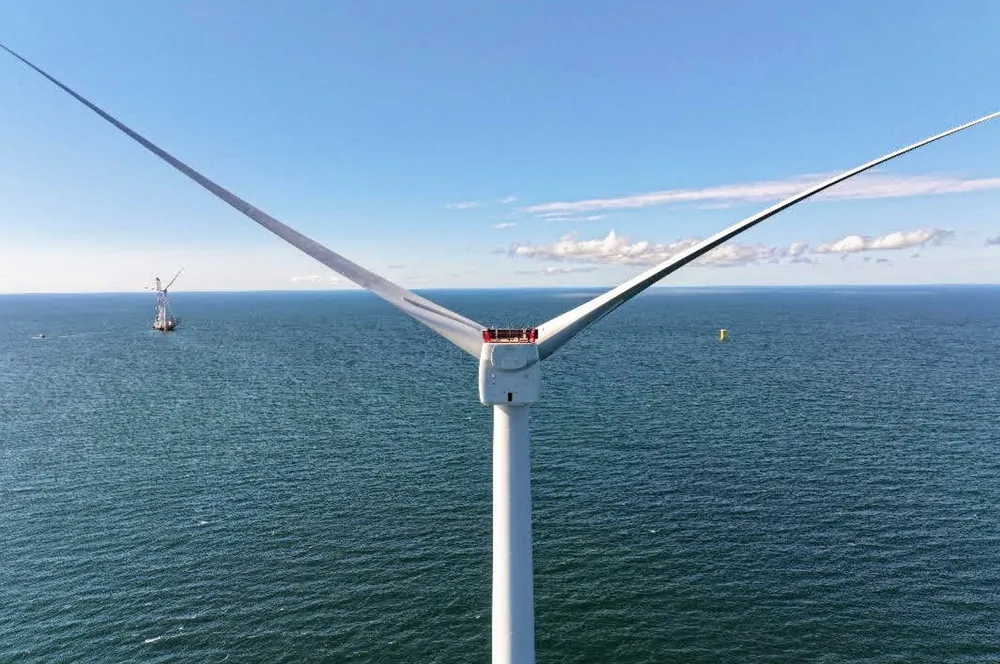GE Vernova’s offshore wind projects back on track as it looks to 'burn down' money losing backlog
Turbine OEM's only two projects, Vineyard Wind in the US and Dogger Bank in the UK, both suffered delays on blade failures that dragged on bottom line

GE Vernova's Haliade-X turbine installations are back on track at its only two projects, the 800MW Vineyard Wind array off Massachusetts and the 3.6GW Dogger Bank in the UK, with a combined 56 units installed so far.
“We're back to installing both of our projects in the North Sea and in the Atlantic, including blades,” CEO Scott Strazik said during the company’s Investor Day Tuesday.
“We will be materially complete with Vineyard Wind in 2025. We've got a pathway to materially complete with Dogger bank in 2026, but you can see, as we see it today, there could be a stump period that goes into ’27,” he added.
Vineyard will eventually have 64 turbines, while Dogger Bank will come in at 277.
Both projects have been plagued with blade failures on the 13.7MW turbines, which led to lengthy delays and in the case of Vineyard, a government-imposed moratorium on installation until a “root cause analysis” and mitigation measures could be enacted.
Turbine installation at the project jointly owned by Copenhagen Infrastructure Partners and Iberdrola’s Avangrid was stopped by the federal Bureau of Safety and Environmental Enforcement (BSEE), which also halted all power generation from the 10 completed turbines.
After a first-hand inspection with Vic Abate, who leads the wind segment, Strazik said they ordered a full production line halt.
“We made the decision we were going to go and reinspect every single offshore wind blade that we have manufactured here to date,” he said. “That cost us a lot of time. It cost us multiple months of good weather execution out in the field. It cost us a lot of money."
'Burn down' backlog
While the OEM is going to continue to look for opportunities to accelerate completion of this backlog, “We’re also not going to do stupid economic things just to buy ourselves two quarters and accelerate stop talking about offshore wind,” he said.
“At the moment, the trade space we’ve seen in the last 3-4 months to move faster doesn’t really make economic sense for us or our customers, but we'll keep looking at it,” said Strazik.
“But on a run-off equipment book, we’re not going to do unnatural acts to simply be done with this thing sooner. So this is the burn down that we see today,” he said.
Wind leader
The company experienced major upheaval as the US offshore wind projects collapsed amid inflationary headwinds over the last couple of years, with gigawatts of contracts evaporating.
“We do expect wind to improve, but not yet achieving profitability given the offshore wind blade events that we had this year, which effectively delayed the installation timeline,” CFO Ken Parks said during the same event.
"We do expect offshore ebitda losses will modestly improve in 2025 as we are thoroughly in the installation cycle in our offshore wind business."
The company has previously said it wouldn’t take new orders for its 13.7MW Haliade-X turbines until costs and pricing were satisfactory.
“In 37 months, we have not taken one new order. We are not going to chase bad deals. We are not going to do it because of growth projections, we’re not going to do it because of decarbonisation commitments,” said Strazik.
“We are not going to follow through on bids with strategic customers in states that matter to us in the US and accept the orders if the economics don’t make sense,” he added, noting, “What our teams are learning through that is we do not expect, we will not allow them to go chase bad business regardless of the reason why.”
Strazik said that the company is looking to hasten completion of its offshore wind backlog, “but we're also not going to do stupid economic things just to buy ourselves two quarters and accelerate stopping talking about offshore wind.”
Whether this indicates that the company is exiting the offshore wind industry remains unclear.
“We're early in the installation cycle for our offshore wind business, and therefore we're taking a bit of a cautious approach as we give you guidance around that business,” said CFO Parks.
Strazik added that the company is working hard “to synergise our offshore wind business with our onshore wind business from a cost structure perspective.”
“We've announced our restructuring of that business so that we can position our wind business to lead this industry going forward,” he added.
(Copyright)